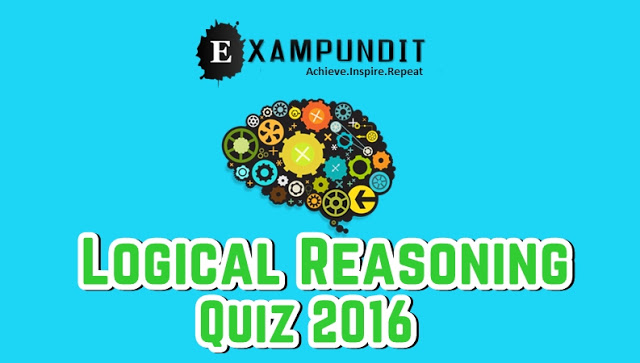
Hello and welcome to exampundit. Here is a set of Reasoning Quiz for upcoming SBI Clerk in 2016 based on Syllogism and Seating Arrangement.
Read the followings carefully and answer
Rules:
Post answers according to the following format(s)
1-2
2-3
3-4
Or
12345
54213
In case the options are ABCD, use the Appropriate Options.
Do Not Rectify anyone.
If you have any doubt regarding any question of the quiz, kindly ask after the quiz is over i.e answers given.
DO NOT GOOGLE ANSWERS!! IT WILL HAMPER YOUR PREPARATION
Do Not CHAT here. If you have any query, use today’s Ask The Mentor Page.
At least 8 Attempts for Scores.
Exampundit.in reserves the right to choose winner or give scores.
Directions (Q. 1-6): In each of the questions below are given four
statements followed by four conclusions numbered I, II, III & IV. You have to take the given statements to be
true even if they seem to be at variance with commonly known facts. Read all
the conclusions and then decide which of the given conclusions logically
follows from the given statements disregarding commonly known facts.
statements followed by four conclusions numbered I, II, III & IV. You have to take the given statements to be
true even if they seem to be at variance with commonly known facts. Read all
the conclusions and then decide which of the given conclusions logically
follows from the given statements disregarding commonly known facts.
1. Statements:
All rockets are poles.
All rockets are poles.
Some poles are trams.
Some trams are ropes.
All ropes are tents.
Conclusions: I. Some tents are trams.
II. Some ropes
are rockets.
are rockets.
III. Some trams
are rockets.
are rockets.
IV. Some poles
are rockets.
are rockets.
1) Only I and II follow
2) Only I, II and III follow
3) Only I and III follow
4) Only I and IV follow
5) None of these
2. Statements:
All dials are mirrors.
All dials are mirrors.
All mirrors are spoons.
Some spoons are decks.
Some decks are chairs.
Conclusions: I. Some decks are mirrors.
II. Some spoons
are dials.
are dials.
III. Some decks
are dials.
are dials.
IV. Some chairs
are spoons.
are spoons.
1) None follows
2) Only I follows
3) Only II follows
4) Only III follows
5) Only IV follows
3. Statements:
Some houses are forests.
Some houses are forests.
All forests are trees.
Some trees are hills.
All hills are buses.
Conclusions: I. Some buses are trees.
II. Some trees
are houses.
are houses.
III. Some hills
are houses.
are houses.
IV. Some buses
are forests.
are forests.
1) Only I and II follow
2) Only I, II and IV follow
3) Only I, II and III follow
4) All I, II, III and IV follow
5) None of these
4. Statements:
Some lakes are rivers.
Some lakes are rivers.
Some rivers are mountains.
Some mountains are books.
Some books are papers.
Conclusions: I. Some books are rivers.
II. Some papers
are lakes.
are lakes.
III. Some
mountains are lakes.
mountains are lakes.
IV. No paper is a
lake.
lake.
1) None follows
2) Only either II or IV follows
3) Only II follows
4) Only IV follows
5) Only either II or IV and III follow
5. Statements:
Some tigers are horses.
Some tigers are horses.
All horses are goats.
All goats are dogs.
Some dogs are cats.
Conclusions: I. Some cats are tigers.
II. Some dogs are
horses.
horses.
III. Some goats are
tigers.
tigers.
IV. Some cats are
horses.
horses.
1) Only I and II follow
2) Only I, II and III follow
3) Only II and III follow
4) Only II, III and IV follow
5) None of these
6. Statements:
All notebooks are pens.
All notebooks are pens.
No pen is a table.
Some tables are desks.
All desks are tanks.
Conclusions: I. Some tanks are pens.
II. Some desks
are notebooks.
are notebooks.
III. Some tanks
are tables.
are tables.
IV. No tank is a
pen.
pen.
1) Only I follows
2) Only III follows
3) Only IV follows
4) Only either I or IV follows
5) Only either I or IV and III follow
Directions (Q. 7-11):
Study the following information carefully and answer the questions given below:
P, Q, R, S, T, V, W and Z are sitting round a circle facing
the centre. T is second to the right of R, who is third to the right of P. S is
second to the left of P and fourth to the right of Q. Z is third to the right
of V, who is not an immediate neighbour of P.
the centre. T is second to the right of R, who is third to the right of P. S is
second to the left of P and fourth to the right of Q. Z is third to the right
of V, who is not an immediate neighbour of P.
7. In which of the following combinations is the first
person sitting between the second and the third persons?
1) VTS
2) TZS
3) QRV
4) PWQ
5) VRT
8. Who is second to the right of T?
1) S
2) Z
3) P
4) R
5) None of these
9. What is P’s position with respect to S?
1) Fourth to the left
2) Fourth to the right
3) Fifth to the left
4) Sixth to the left
5) Third to the right
10. Who is on the immediate left of Z?
1) T
2) P
3) S
4) V
5) None of these
11. Who is second to the right of W?
1) R
2) Q
3) Z
4) S
5) None of these
:: VIEW SOLUTIONS ::
For Mock Tests of UIIC AO 2016: Click Here
Regards
Team ExamPundit


